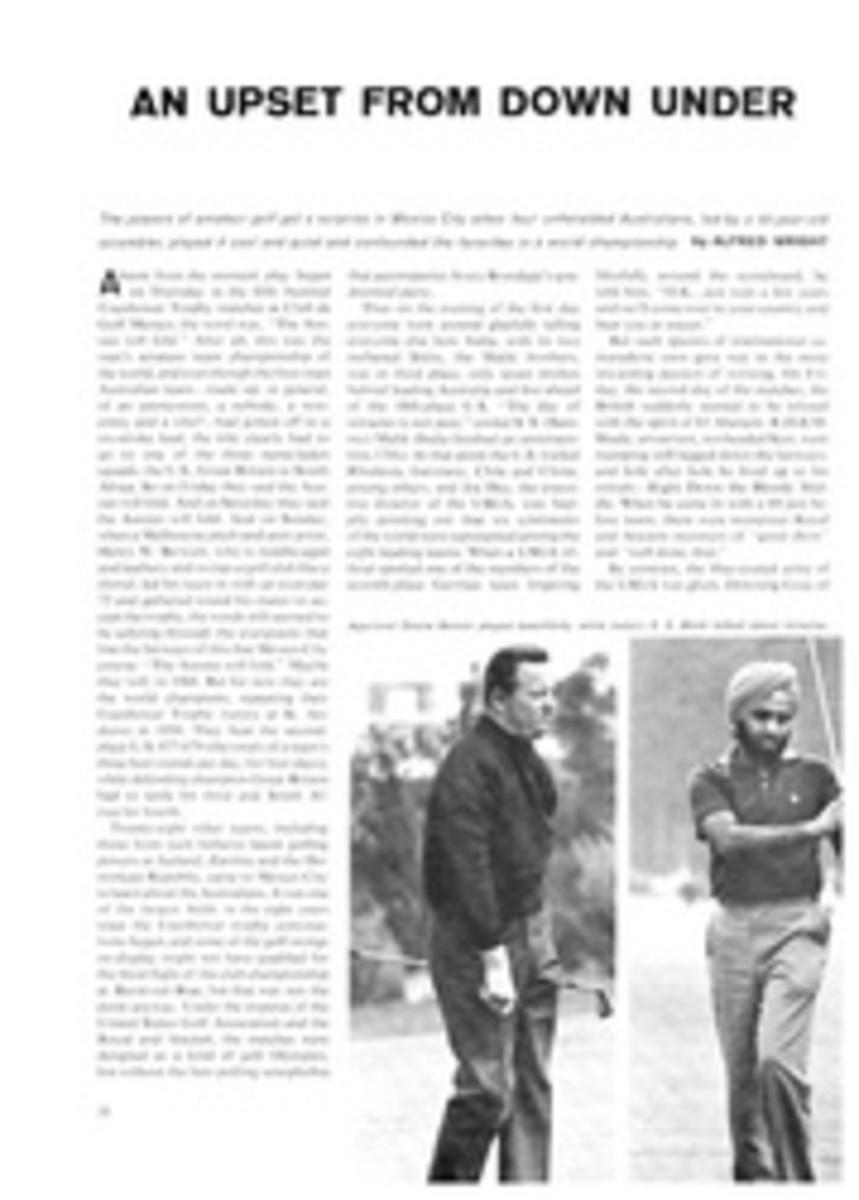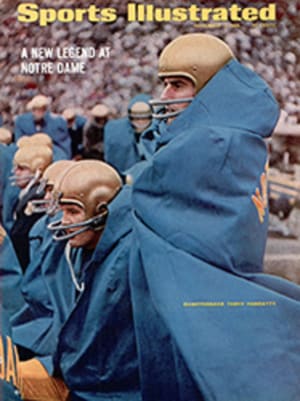
AN UPSET FROM DOWN UNDER
Almost from the moment play began on Thursday in the fifth biennial Eisenhower Trophy matches at Club de Golf Mexico, the word was, "The Aussies will fold." After all, this was the men's amateur team championship of the world, and even though the four-man Australian team—made up, in general, of an anonymous, a nobody, a nonentity and a who?—had gotten off to a six-stroke lead, the title clearly had to go to one of the three name-laden squads: the U.S., Great Britain or South Africa. So on Friday they said the Aussies will fold. And on Saturday they said the Aussies will fold. And on Sunday, when a Melbourne pitch-and-putt artist, Henry W. Berwick, who is middle-aged and leathery and swings a golf club like a shovel, led his team in with an even-par 72 and gathered round his mates to accept the trophy, the words still seemed to be echoing through the evergreens that line the fairways of this fine Mexico City course: "The Aussies will fold." Maybe they will, in 1968. But for now they are the world champions, repeating their Eisenhower Trophy victory at St. Andrews in 1958. They beat the second-place U.S. 877-879 (the totals of a team's three best rounds per day, for four days), while defending champion Great Britain had to settle for third and South Africa for fourth.
Twenty-eight other teams, including those from such hitherto latent golfing powers as Iceland, Zambia and the Dominican Republic, came to Mexico City to learn about the Australians. It was one of the largest fields in the eight years since the Eisenhower trophy convocations began, and some of the golf swings on display might not have qualified for the third flight of the club championship at Burnt-out Brae, but that was not the point anyway. Under the impetus of the United States Golf Association and the Royal and Ancient, the matches were designed as a kind of golf Olympics, but without the hair-pulling xenophobia that accompanies Avery Brundage's quadrennial party.
Thus on the evening of the first day everyone went around gleefully telling everyone else how India, with its two turbaned Sikhs, the Malik brothers, was in third place, only seven strokes behind leading Australia and five ahead of the 10th-place U.S. "The day of miracles is not past," smiled S. S. (Sammy) Malik (India finished an unmiraculous 17th). At that point the U.S. trailed Rhodesia, Germany, Chile and China, among others, and Joe Dey, the executive director of the USGA, was happily pointing out that six continents of the world were represented among the eight leading teams. When a USGA official spotted one of the members of the seventh-place German team lingering blissfully around the scoreboard, he told him, "O.K., just wait a few years and we'll come over to your country and beat you at soccer."
But such spasms of international camaraderie soon gave way to the more rewarding passion of winning. On Friday, the second day of the matches, the British suddenly seemed to be infused with the spirit of El Alamein. R.D.B.M. Shade, an earnest, towheaded Scot, went tramping stiff-legged down the fairways, and hole after hole he lived up to his initials—Right Down the Bloody Middle. When he came in with a 69 just before noon, there were numerous Royal and Ancient murmurs of "good show" and "well done, that."
By contrast, the blue-coated army of the USGA was glum. Downing Gray of Pensacola, Fla., who has been one of our steadiest players for the last five years, staggered in early with a disastrous 80. The word spread that Deane Beman, our best amateur today and the mainstay of the team, had hurt his back and could scarcely swing a club. The blue coats rushed out to observe Deane, who was making bogeys, wincing with pain and thinking of quitting. After driving off the 13th tee, Beman asked what Gray had shot. When he heard the answer he winced again, for it meant he had to keep going in hopes of improving on Gray's 80. He hit some impeccable shots, and played the last six holes one under par for a courageous 73.
Then Bob Murphy, the chunky, redheaded Floridian who won our amateur championship last year, turned in a very steady round for the U.S. in the late afternoon to finish with 71. That, coupled with the 73 of young Ron Cerrudo, put the U.S. in contention, too—tied for third with Britain.
The only trouble was that the Australians refused to behave according to expectations. They were seven shots worse than their opening-day score of two-under-par, but they still maintained a comfortable seven-stroke lead over second-place South Africa. Kevin Hartley, a 32-year-old engineer whose 68 had gotten Australia started on Thursday, soared to a 78, but Phil Billings had a 74, Kevin Donohoe a 72 and Berwick a 75, which isn't exactly folding.
On Saturday morning it seemed as if the name of the event might have to be changed to the Lower Lumbar Open. First it was learned that Luis Silverio, the splendid little Filipino player who had gone from a 72 on Thursday to an 82 on Friday, was suffering from a back ailment as severe as Beman's. Next, on the fourth tee, Britain's Mike Bonallack literally fell on his face after hitting his drive. He was while with pain and had to be helped to his feet by Joe Carr, the team captain. Like Beman, he struggled onward and a good thing, too, for his hard-earned 76 was badly needed by the British, because Peter Townsend, the 20-year-old Wunderkind of the squad, had had his third disastrous round, this one an 84. Shade's even-par 72 was the only bright spot for the British, and his 68 on the final day enabled him to win the individual trophy, but Bonallack's injury and Townsend's wildness ended the British chances.
The day really belonged to South Africa. First off, 18-year-old Bobby Cole, the presiding and precocious British amateur champion, came in with a 70. This was what everyone had been expecting, since the feeling is strong in golfing circles that Bobby will be the next star to follow in the footsteps of Palmer, Nicklaus and Gary Player. He is a skinny youth with arms that dangle almost to his knees, and his mannerisms are such that from a distance he might very well be mistaken for his countryman. There the resemblance with Player ends, for Bobby is pale, with kinky, sandy-colored hair and a visage of innocence that attracts a gallery of teen-age misses who look like spillage from the Beatles.
Cole had been extremely erratic the first two days, playing the first nine holes in a total of 81 and the back nine in 66. By Saturday, however, his long wood shots were under control, and he was able to put together two good nines, while his older teammate David Symons contributed another 70. It had happened at last: Australia was out of the lead, trailing South Africa by one stroke. Five strokes further back was the U.S. And who do you suppose had moved into fifth, where they eventually finished? The Mexicans, genial hosts who were surprising even themselves.
In Mexico golf is about as popular as cowardly bulls, but this sudden success helped bring out a small, chattering, laughing Mexican gallery to see Sunday's action, in which the main attraction was a threesome consisting of Beman, South Africa's Cole and Australia's Berwick.
Cole, who was pretty much expected to carry South Africa to victory, sailed along for six holes, hitting his drives 70 to 80 yards ahead of his opponents and sinking a pair of birdie putts that put him two under par. Suddenly, at 7, he missed a 12-incher—the greens were very rough—and then, at 8, he missed another. Shaken, he drove into the rough at 9, ended with a double bogey, and eventually finished with a 77 that left South Africa in trouble from which his lesser teammates could not recover.
Beman, meanwhile, was playing one of the dream rounds of his career. On the first nine he only once failed to have a birdie putt of less than 18 feet, but he could not sink the putts. Then he did birdie three of the next four holes, and came in with a 69.
This might have considerably closed the gap on Australia, but Berwick was unimpressed. His swing looked like a 15-handicapper's, but he somehow would get the ball close to the green, then chip it dead to the stick for a par and a par and more pars, until he was in with his even-par 72. Hartley, meantime, shot a 73, and either of the 74s by Donohoe or Billings was enough for Australia's victory. Australia had won, not with any spectacular show of strength, and not by unveiling any surprise players who are likely to take the world by storm, but with an exhibition of remarkably steady golf under nerve-testing conditions.
Since 1962, the Eisenhower Trophy has been won by three different countries—the U.S., Great Britain, and Australia—which is just the kind of intense competition that the USGA and the Royal and Ancient and all of the other sponsoring bodies hoped their "Olympics of Golf" would become.
TWO PHOTOS
Agonized Deane Beman played beautifully, while India's S. S. Malik talked about miracles.
PHOTO
Kevin Hartley's opening 68 set Aussie pace.

